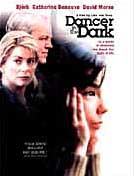|
|||
|
A
p r i l 2 0 0 1
|
|||

tripewriter
Pop,
parable and a desperate need for joy The scratch of a pencil, the industrial din of machinery, the skipping of a phonograph needle, a train on the tracks -- glorious music is sparked by all these things and more in "Dancer in the Dark." The Lars Von Trier film, last year's 154th-highest-grossing, was released to sudden death in September, and only five people attended a Sunday afternoon showing at Portland's Hollywood Theater during the March second run. But recent DVD release, including outtakes and a pair of how-did-they-do-that documentaries, makes a persuasive case for the newfangled format.
Selma's salvation is vivid imagination, which takes over whenever things become especially grim. That's when the sounds of life give way to the music in her head, and washed-out colors from a solitary hand-held camera give way to the vivid colors of 100 cameras, which capture exuberant full-blown song-and-dance production numbers from every conceivable angle. The film's overall effect is extreme: ugly and beautiful, well-acted and pretentious, upliftingly sweet, harrowingly repulsive and melodramatic beyond belief. It's both the Mona Lisa and the hideous accident from which you can't look away. The extremes began with the three-year span it took Von Trier to finish the film, which then won the 2000 Palme d'Or -- the big prize at Cannes -- along with Best Actress for the incomparable Icelandic pop sprite, Björk. Wrote film critic Roger Ebert: "The first press screening at Cannes was at 8:30 a.m. That's the screening where all the real movie people attend -- the critics, festival heads, distributors, exhibitors, film teachers, other directors, etc. (the evening black-tie audience is far more philistine). After the screening, the auditorium filled with booing and cheering -- so equal in measure that people started booing or cheering at each other." "Love it" and "Hate it" are the choices greeting visitors at dancerinthedarkmovie.com. Simple-souled Selma works in a rural Pacific Northwest sheet-metal factory, circa 1964, and moonlights by attaching hairpins to cardboard for pittance. Music is the respite from her downtrodden existence; she rehearses a role in the local production of "The Sound of Music" and attends screenings of classic Hollywood musicals with her devoted friend, Kathy, in her minimal spare time. At one poignant point, Kathy, played by an understated Catherine Deneuve, walks two fingers across her increasingly blind friend's palm to describe the dancing on the screen. At another, Selma recounts her Czechoslovakian childhood habit of leaving the theater before a film's final number -- that way the show, at least in Selma's mind, never has to end. But when a couple wicked plot-twists kick in, hold onto your popcorn. Sure, it's pure parable that demands wholesale suspension of disbelief. But we don't need to know why Snidley Whiplash ties Nell Fenwick to the railroad track to appreciate the subsequent examination of the human condition. "It took me two years to become Selma," Björk said at a post-Cannes press conference, "and one year to become me again. After reading the script, very quickly, I wrote the songs for her with a lot of pain. I have never felt that kind of pain in my life. I'm very lucky -- I've had a very good life. All of my dreams have come true and more so. None of her dreams come true." The 35-year-old Björk Gudmundsdottir's star hit these shores in the late 1980s, as a member of the charmingly eccentric Sugarcubes; she still proclaims herself a punker, although her songs for "Dancer" betray nearly anything but. Björk began recording in Iceland at age 11; her 14 albums include jazzy torch, cockeyed rock and modern-day dance to rival all comers. And, despite her reported insistence that she'll never act again, that we've yet to see the full flower of her off-kilter gifts is a better bet than any futures Wall Street can proffer. As legend has it, Björk demanded her songs be put into the film at full length, which only helped ensure that the film is as long in duration as the lines to see it have been short -- despite an Oscar nomination for her duet with Thom Yorke. "It was time someone could speak out for loners and introverts who are in kind of a fantasy bubble," Björk said. "I spent most of my childhood on my own, and I was in heaven in a spiritual high. Our society tells us that people who are on their own are sad losers. But I think that these people are very self-sufficient. If I had to pick out of the 100 peaks of my life, 90 I had on my own." Left unsaid is the film's underlying insinuation: a break here or there, and Selma's life might have been so much more. But Selma doesn't get a break. "Maybe that's one of the reasons I wanted to do the music for Selma," Björk said. "When people are that dark, the need for joy is so desperate that when they get those flights, they are not artificial -- they're real. And that's the victory of the human spirit. I think it is very easy to love her, she is so pure." Sometimes art imitates life, sometimes life imitates art. And sometimes we get lucky and can't tell which is which. |
|||
|
E-mail Mark at andersonenterprises@hotmail.com,
and visit prior editions of tripewriter.
|
|||
|
|
|||
|
|



 "Dancer
in the Dark" tells the glum story of Selma, an immigrant single
mom going congenitally blind while working two jobs to save money
for an operation that might save her young son from a similar fate.
"Dancer
in the Dark" tells the glum story of Selma, an immigrant single
mom going congenitally blind while working two jobs to save money
for an operation that might save her young son from a similar fate.